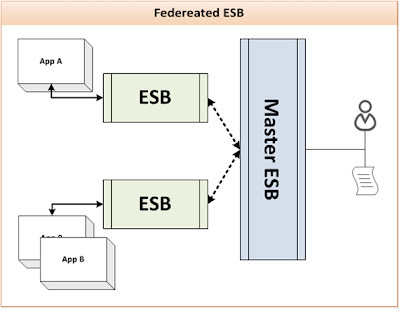Modern Enterprise Service Bus (ESB) is inherited from classic computing concept of Information Bus from 80s and ESB was glamorized in late 90’s early 2000s by technology giants TIBCO, Oracle, IBM and SAG. In last decade a lot of open source players have also forayed in the mainstream competition and produced some amazing ESB products, especially Mule, Fuse, WSO2 and Red Hat. This disruption in ESB market has only helped the end consumers and enterprises alike.
The popularity of SOA and Cloud solutions has also helped ESB penetrate deeper into the enterprise architecture landscape. Not only does ESB enhance SOA and Cloud experience but it also helps address the security related concerns to a great extent, for entire enterprise/LOB by working in a “Brokered Authentication” pattern and becoming single point of authentication & authorization. Though the mechanism varies vastly between offerings and also between enterprises, the underlying principle remains the same.
However the advancements and refinement in the ESB products in last couple of decades do not necessarily guarantee higher ROI and lower TCO for the enterprises that chose to use ESB solutions. At the end of the day it all depends on how one deploys the ESB within the EA landscape and how the EA lays down the road-map for ESB within IT organization. Please remember that ESB is just a mean to more robust EA, just an enabler.
In next sections I share my own experiences in ESB deployment topology and patterns to help the reader evaluate and compare the possible solutions for his/her use case(s). I suggest the reader to be very critical during project requirement evaluation phase and do not hesitate to use a combination of 2 or more deployment topology discussed below.
Global ESB Pattern:
- Single namespace and canonical model for all service components interactions.
- Easy to maintain, scale and govern
- Easy to implement in SME.
- Most suitable pattern for heterogeneous, centrally administered and globally centralized EA landscape.
- The large number of integration in large enterprise makes this pattern a less favorable option since a single canonical model would be difficult to conceive and manage.
- Ideal approach for this pattern would be bottom-up, however in case you already have a considerable EA landscape and ESB is new entrant in otherwise mature EA a combination of bottom-up and top-down approach, i.e. meet in the middle, should be considered.
Directly Connected ESB Pattern:
- One of the most popular and successful deployment pattern for ESB
- It provides means to ‘global decentralization’ and ‘local centralization’ of service components.
- Most suitable for large organizations with geographically distributed EA landscape and/or multiple LOBs.
- This is particularly popular and effective in cloud implementations involving hybrid deployment strategy. The hybrid cloud model would be represented by an ESB on premise and the other directly connected ESB on cloud (NOTE: Please consider the complexity related to PII and PCI compliance when working with Directly Connected ESBs in hybrid cloud model).
- Common service registries could facilitate service discover-ability and also make the service governance manageable and overall architecture scalable.
- The esb2esb communication protocol facilitates hiding the service component implementation details providing loose coupling and abstraction.
- The esb2esb communication is associated with moderately high latency
Brokered ESB Pattern:
- It is a direct representation of the classic HUB-SPOKE model
- The broker selectively exposes service components to providers, consumer and partners.
- This deployment patterns is best suited for large organizations with multiple trading partners, operations and/or platforms
- The broker ESB regulates the communication and data/info exchange between multiple ESB installations on both sides, where each individual installation in managed and/or governed separately
- Maintenance of service registries and repositories is complex and costly proposition.
- Over a period of time, this pattern is most vulnerable to Spaghetti (hairball) anti-pattern.
- Brokered pattern induces inherent latency in the business process and is NOT suitable for use case where latency is critical parameter/KPI.
Federated ESB Pattern:
- It is the most frequently advised ESB pattern, however in my opinion it’s one of the most difficult to pull-off ESB patterns, owing to complexity associated with lateral components of governance.
- It is good representative of a being referred to as a ‘global ESB pattern’ since it is applicable in multiple use cases, ranging from decentralized to centralized EA, from heterogeneous to homogeneous EA etc.
- I like to refer to it as ‘Glorified one-to-many Broker ESB pattern’.
- It is a good pattern for a use when you want to enforce integration governance from top-bottom and want to closely monitor/track interfaces, KPI and service components.
- This pattern is a good candidate for an enterprise with multiple centrally managed LOBs
- Governance should be considered a mandatory requirement when implementing this pattern; else it could lead to ‘Blob’ and/or ‘Poltergeists’ application anti-pattern.
- Infrastructure and capacity analysis should be done diligently to deal with the service throughput and latency related requirements (and other NFR). Inefficiently structured federated ESB tier could lead to Stovepipe systems, which could choke the federated tier.
In my professional experiences I have come to believe that every organization has unique integration scenarios, situations, challenges and requirements – requiring very pragmatic and open view towards each. I maintain that ESB (for that matter any other COTS) is not the end, but merely one of many possible means to reach the end.



